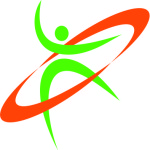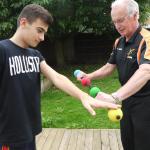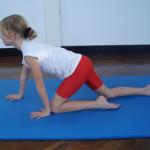
This strap-line MOVEMENT – LEARNING – PERFORMANCE highlights the guiding principles for all Physfun’s Programmes.
Physical Movement increases brain integration and one of the best ways to get both sides of the brain working together and improve nerve connections is to engage cross-lateral physical movement.
This means limbs on one side of the body, cross the body’s mid-line and coordinates with limbs on the other side of the body so that both sides of the brain are being used at once e.g. see below;
Crawling in early development is very important as children who miss or shortchange this stage are more likely to have learning difficulties.
These movements help learning by not just using bones and muscles but by using nerve pathways in the brain and between the brain and the rest of your body. The movements seen above use many of the same pathways that you would use to write or gesture with in learning activities. The more the nerve pathways are stimulated the more efficiently they work for all activities.
Mat based rocking, rolling and sliding movements stimulate the senses and help develop the nerve networks from the Cerebellum to the Basal Ganglia ( Brain Stem) through to the Limbic system (the emotional brain), the Neocortex (The two hemispheres) through to the Prefrontal cortex. A clear indication of a lack of integration is the inability to do certain movements rhythmically, smoothly and symmetrically. Doing a series of mat based movements regularly will help those with delayed development achieve expected milestones.
 Other vital movements involve those that stimulate the vestibular system, considered the ‘entry to the brain’ because it maintains alertness to all incoming stimuli. This sensory-motor system connects the inner ear with the brain stem, eyes and core muscles, regulating our balance for all locomotor movements from standing on one foot to holding a pencil to write with.
Other vital movements involve those that stimulate the vestibular system, considered the ‘entry to the brain’ because it maintains alertness to all incoming stimuli. This sensory-motor system connects the inner ear with the brain stem, eyes and core muscles, regulating our balance for all locomotor movements from standing on one foot to holding a pencil to write with.
The third component of individualized Physfun Programmes involves exercises with bean bags (see video) and special balls that require thousands of mid-line crossings in three dimensions. These exercises are rhythmic and involve the auditory system, enabling the mind-body system to experience ‘symmetrical flow’.
Finally once the above foundations have been improved (depending on age and developmental progress) Fundamental Movements using the unique M System can be incorporated to focus on moving forwards, sideways, upwards and in multi directions with the inclusion of manipulation skills.
Thus the EDRP intervention Programme will use a tailored-made combination of Mat based floor exercises, rhythmic movements, balance challenges, eye-hand / eye-foot / hand –eye – foot coordination based exercises to provide a stimulating solution to a whole range of developmental movement and learning issues.
The EDRP intervention Programmes lend themselves to improving inter-personal skills, (e.g.working in cooperation with others) as well as cognitive, emotional and behavioural qualities.
Most importantly all of the aforementioned is guaranteed to support and improve ALL LEARNING!




